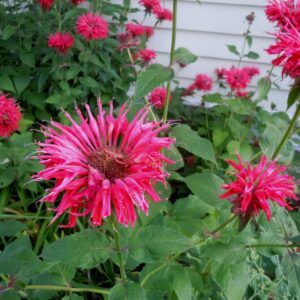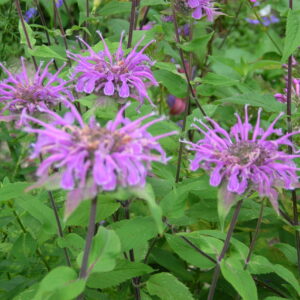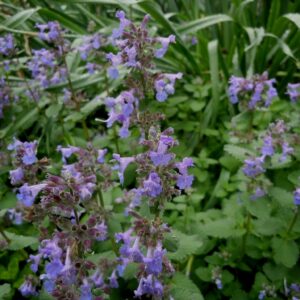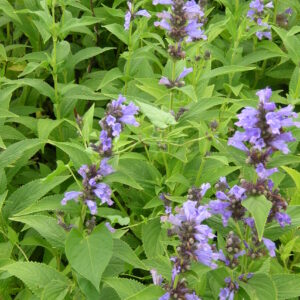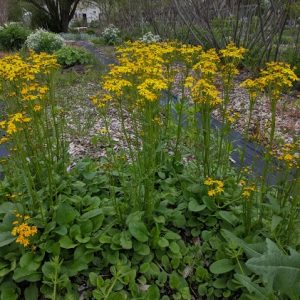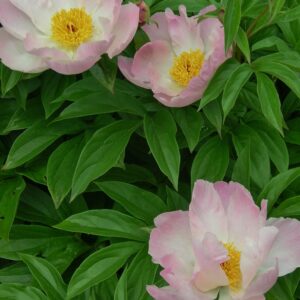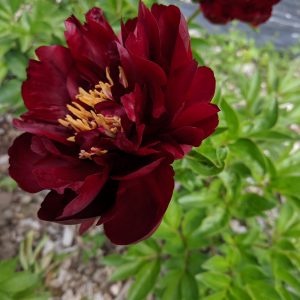Deer Resistant Plants
Showing 97–104 of 170 results
-
Monarda didyma ‘Cambridge Scarlet’ Beebalm Z 4-9
Whorls of scarlet tubes & bracts looking like fireworks, in summer
Whorls of scarlet tubes & bracts looking like fireworks, in summer
Size: 3-4' x spreading
Care: sun to part shade in well-drained soil.
Native: N. E. America
Wildlife Value: Checkered white, Fritillary and Melissa blue butterflies relish Beebalm’s nectar.Cherokee used the species medicinally, to cure colic, flatulence, nosebleed, measles, flu, hysteria and to induce restful sleep. Monarda was named in honor of Nicholas Monardes (1493-1588), a Spanish botanist who wrote about plants of the New World. Discovered by John Bartram (1699-1777) being used by colonists in Oswego N.Y. to make tea. Oswego Indians taught the colonists how to make tea from the dried leaves. Bartram sent this Beebalm to Peter Collinson in England in whose garden it grew in 1744. By 1757 its English availability was “nearly universal” among gardeners. During the American Revolution used as a substitute for tea. Grown at America’s 1st botanic garden, Elgin Botanic Garden 1811.This cultivar ‘Cambridge Scarlet’ recommended by Gertrude Jekyll in 1908.
-
Monarda fistulosa Wild bergamont Z 3-9
Whorls of hooded lavender tubes in July - August
Whorls of hooded lavender tubes in July – August
Size: 3-4' x 2' spreading
Care: Sun to part shade any soil.
Native: central U.S., Wisconsin native
Wildlife Value: Checkered white, Tiger swallowtail, Giant swallowtail and Melissa blue butterflies relish Wild bergamot’s nectar. Supports over 70 bee species including Rusty patched Bumble Bee.Used medicinally by many Native tribes- Blackfoot, Cherokee, Chippewa, Choctaw, Crow, Dakota and Flathead. Cherokee: to cure colic, flatulence, nosebleed, measles, flu, hysteria and to induce restful sleep Blackfoot called it “Single-young-Man.” Teton Dakotas boiled the leaves and flowers for medicine to cure abdominal pain. Ho-Chunk boiled the leaves to make a medicine for pimples. Choctaws cured chest pain in children. The Flathead cured colds and sore teeth with Wild Bergamot. HoChunk inhaled fumes in a sweat bath to cure colds. Oneidas made a tea. For the Sioux it was nourishment and a panacea: tea, stomachache, fever, indigestion, sore throats, fainting, whooping cough, wounds, sore eyes, ulcers, and snakebites. First documented by French explorers before 1635. Plant exported to Europe by Tradescant the Younger in 1637. Grown by Washington at Mount Vernon. Today it is a flavor in Earl Grey tea.
-
Nepeta nervosa Catmint Z 4-9
Chubby spikes of many clear blue-purple flowers blooming June-September. Deadhead to rebloom
OUT OF STOCK
Chubby spikes of many clear blue-purple flowers blooming June-September. Deadhead to rebloom
Size: 16-20” x 18-24”
Care: sun in moist to moist well-drained soil
Native: China
Wildlife Value: deer & rabbit resistant, attracts bees & butterfliesNepetas may have been named after Nepete, an old Etrusrian city. Nervosa means with conspicuous veins. Collected before 1833.
-
Nepeta racemosa syn. N. mussinii Catmint Z 4-8
Lavender blue from May through September, cut back for rebloom
Lavender blue from May through September, cut back for rebloom
Size: 18" x 18"
Care: Full sun in well-drained soil
Native: Caucasus
Wildlife Value: attracts butterflies and bees
Awards: Royal Horticultural Society Award of Merit.Nepetas may have been named after Nepete, an old Etrusrian city. Mussinii named for the plant’s discoverer, Russian Count Apollos Apollosovitch Mussin-Pushkin. In gardens before 1810 and a favorite Victorian bedding plant by the late 1800’s. Catmints contain various amounts of an essential oil (nepetalactone) both a cat stimulant and a mosquito repellant.
-
Nepeta subsessilis Japanese catmint Z 4-8
Showy bluish-purple spikes of bell-shaped flowers forming short spikes, June-September
Showy bluish-purple spikes of bell-shaped flowers forming short spikes, June-September
Size: 18-24” x 18-24”
Care: sun to part shade in moist to moist well-drained soil
Native: Japan
Wildlife Value: deer & rabbit resistant, attracts butterfliesSubsessilis means nearly without stalks. Catmints contain various amounts of an essential oil (nepetalactone) both a cat stimulant and a mosquito repellant. From Nambu Japan where botanists called it Miso-gawa- sô. Von Siebold, German botanist and physician, who worked in Japan from 1823 to1830, saw it. Named in Bull. Acad. Imp. Sci. Saint-Pétersburg, sér. 3, 20: 469. (1875) by Russian botanist Karl Maximowicz.
z.
-
Packera obovata syn. Senecio obovata Round-leaved ragwort, Golden groundsel Z. 3-8
Clusters of perky yellow daisies with sunny centers atop nearly leafless, erect stems, blooming late spring to early summer. Missouri Botanic Garden: “Vigorous spring wildflower for sunny or shady areas of the landscape. Large, naturalized plantings in woodland gardens can be spectacular in bloom. Cut off flowering stems after bloom and enjoy the semi-evergreen basal foliage which forms an attractive ground cover.”
Clusters of perky yellow daisies with sunny centers atop nearly leafless, erect stems, blooming late spring to early summer. Missouri Botanic Garden: “Vigorous spring wildflower for sunny or shady areas of the landscape. Large, naturalized plantings in woodland gardens can be spectacular in bloom. Cut off flowering stems after bloom and enjoy the semi-evergreen basal foliage which forms an attractive ground cover.”
Size: 1-2’ x 6-12” spreading
Care: sun to part shade in moist to moist well-drained soil
Native: curved swath from eastern Canada to FL west to IL and NM
Wildlife Value: attracts bees. Deer resistantObovata means egg-shaped describing the shape of its basal leaves. First named in 1803 from a plant of Rev. Henry Muhlenberg (1783-1815) (https://en.wikipedia.org/wiki/Gotthilf_Heinrich_Ernst_Muhlenberg,) Pennsylvania plantsman, sent to German botanist Carl Ludwig Willdenow (1765 – 1812). Packera named for a Canadian botanist, John G. Packer.
-
Paeonia ‘Seashell’ Sea Shell peony Z 3-8
Blousy, single, ballerina pink petals 6” across, surround golden centers in mid-season, sweetly fragrant.
Blousy, single, ballerina pink petals 6″ across, surround golden centers in mid-season, sweetly fragrant.
Size: 36"x 36"
Care: sun to part sun in moist well-drained soil. Plant “eyes” no deeper than 2” below soil. If planted too low, it will not flower.
Wildlife Value: Deer resistant.
Awards: American Peony Society Gold Medal in 1990.Paeonia is derived from the Greek mythical figure Paeon, who Pluto turned into a flower. Theophrastus described the peony around 300 B.C. Dioscorides, 1st century A.D., claimed the root eased the pain of childbirth. During the Middle Ages peonies used in Europe to remedy the falling sickness, cleaning women after child birth, nightmares, and melancholy. The “surest way” to effect a cure was to hang fresh root around the neck. Otherwise an infusion should be taken before and after a full moon. ‘Seashell’ introduced by H.F. Sass in 1937.
-
Paeonia lactiflora Buckeye Belle Z 3-8
Semi-double, velvety blossoms of the deepest red, almost chocolate, with large outer petals surrounding narrow inner petals sprinkled with sparkling golden staminodes.
Semi-double, velvety blossoms of the deepest red, almost chocolate, with large outer petals surrounding narrow inner petals sprinkled with sparkling golden staminodes.
Size: 18-24” x 24-30”
Care: Full sun or part shade in most, well-drained soil
Wildlife Value: Deer and Rabbit resistant, attracts butterflies & hummingbirds, great cut flower
Awards: American Peony Society Gold Medal, American Peony Society Award for Landscape MeritHybridized in the USA in 1956 by Walter Mains

